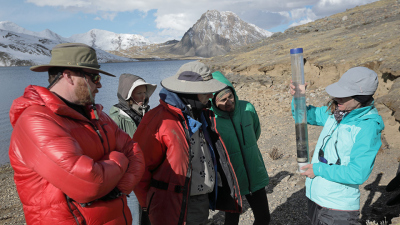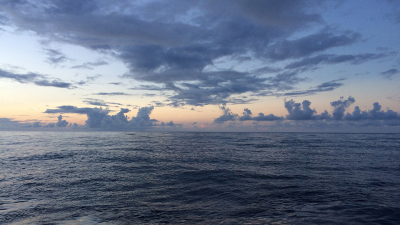- Home
- Discover
- Media Releases
- Media Releases 2023
- watercycle
Study links changes in global water cycle to higher temperatures

To find answers and make informed predictions, scientists look to the past. Reconstructions of past climate change using geologic data have helped to show the far-reaching influence of human activity on temperatures since the Industrial Age. But assembling hydroclimate records for the same timeframe has proved to be much harder.
A study from the Past Global Changes (PAGES) Iso2k project team, including Lukas Jonkers from MARUM - Center for Marine Environmental Sciences, University of Bremen, takes an important step toward reconstructing a global history of water over the past 2,000 years. Using geologic and biologic evidence preserved in natural archives — including 759 different paleoclimate records from globally distributed corals, trees, ice, cave formations and sediments — the researchers showed that the global water cycle has changed during periods of higher and lower temperatures in the recent past.
“The global water cycle is intimately linked to global temperature,” said Bronwen Konecky, an assistant professor of earth, environmental and planetary sciences in Arts & Sciences at Washington University in St. Louis and lead author of the new study in Nature Geoscience.
“We found that during periods of time when temperature is changing at a global scale, we also see changes in the way that water moves around the planet,” she said.
The water cycle is complex, and rainfall in particular has geographic variations that are much more drastic than air temperature. This has made it difficult for scientists to evaluate how rainfall has changed over the past 2,000 years.
“We decided to start with water isotope records because they reflect holistic signals and because they’re recorded in all kinds of different natural archives,” Konecky said. “This is a first step toward reconstructing drought or rainfall patterns at the global scale during the past 2,000 years.”
An intertwined cycle
The global water cycle is vast and intertwined. Water evaporates from the surface of the Earth, rises into the atmosphere, cools and condenses into rain or snow in clouds, and falls again to the surface as precipitation. Each water molecule that is part of the cycle has a certain isotopic ‘fingerprint,’ or composition, which reflects small variations in the atomic weight of the oxygen and hydrogen atoms that comprise the molecule. So, individual water molecules can be heavier or lighter.
With this new study, the scientists found that when global temperature is higher, rain and other environmental waters become more isotopically heavy. The researchers interpreted these isotopic changes and determined their timeline by synthesizing data from across a wide variety of natural archive sources from the past 2,000 years of Earth history.
The PAGES Iso2k project team — which includes more than 40 researchers from 10 countries — collected, collated and sometimes digitized datasets from hundreds of studies to build the database they used in their analysis. They ended up with 759 globally distributed time-series datasets, representing the world’s largest integrated database of water isotope proxy records.
Piecing together signals from many different types of natural archives can be like piecing together apples and oranges. Konecky and the project team knew, however, that water isotopes record climate signals in specific ways in different natural archives. Carefully assembled, this common thread could help them to compare a tree ring to an ice core.
“Every archive is different,” Konecky said. “To make matters more complicated, datasets from different archives are generated by different scientific communities with their own terminology, norms and reference materials. We came up with data description fields (metadata) for the database that translate each record’s particularities into a common tongue that makes it possible to compare variations in one archive to variations in another. This process took years!”
The team met once in person and then did everything afterward by teleconference. They organized co-working sessions at odd hours to accommodate time zones from Hawaii to Japan to Australia to Europe and in between. “We even spent one New Year’s Eve working on the database and the analyses that led to this paper,” Konecky said.
This project shows that it is necessary to combine information from hundreds of studies to learn something new about the global water cycle. "The knowledge gained from this study could never have been obtained by individual scientists," emphasizes Lukas Jonkers. "We were able to combine hundreds of studies, which only works when researchers from many different disciplines work together to rescue data sets from many different sources - and when they find clever ways to combine them."
More water cycle changes to come
Global scale relationships between temperature and the isotopic composition of certain environmental waters, like seawater and glacial ice, have long been recognized as the planet moves in and out of ice age cycles. Local scale relationships with temperature on timescales of minutes to months are also well established.
But this study provides the first evidence that temperature and the isotopic composition of environmental waters go hand in hand at timescales in between these two — that is, over decades to centuries.
It’s a rapid adjustment, Konecky said. “As the planet warms and cools, it affects the behavior of water as it leaves the oceans and the vigor of its motions through the atmosphere,” she said. “The isotopic signals in these waters are very responsive to temperature changes.”
The scientists found that global mean surface temperature exerted a coherent influence on the isotopic composition of global precipitation and “meteoric water” (water in lakes, rivers and ice melts) throughout the past 2,000 years. The changes they observed were driven by global ocean evaporation and condensation processes, with lower values during the period of time known as the Little Ice Age (1450-1850) and higher values after the onset of human-caused climate warming starting around 1850.
When it comes to the specific impact of these changes on future rainfall and water availability, it is too early to predict who will win and who will lose. But this study’s data from the last 2,000 years suggest that more water cycle changes are likely as global temperatures continue to increase. June, July and August 2023 were the hottest months on record for our planet.
MARUM produces fundamental scientific knowledge about the role of the ocean and the seafloor in the total Earth system. The dynamics of the oceans and the seabed significantly impact the entire Earth system through the interaction of geological, physical, biological and chemical processes. These influence both the climate and the global carbon cycle, resulting in the creation of unique biological systems. MARUM is committed to fundamental and unbiased research in the interests of society, the marine environment, and in accordance with the sustainability goals of the United Nations. It publishes its quality-assured scientific data to make it publicly available. MARUM informs the public about new discoveries in the marine environment and provides practical knowledge through its dialogue with society. MARUM cooperation with companies and industrial partners is carried out in accordance with its goal of protecting the marine environment.
Originalpublikation:
Konecky, B.L., McKay, N.P., Falster, G.M. et al. Globally coherent water cycle response to temperature change during the past two millennia. Nat. Geosci. (2023). DOI: 10.1038/s41561-023-01291-3
Contact:
Scientist contact:
Dr. Lukas Jonkers
MARUM – Center for Marine Einvironmental Sciences, University of Bremen
Micropaleontology - Paleoceanography
E-Mail: [Bitte aktivieren Sie Javascript]
Press contact:
Ulrike Prange
MARUM Press and Public Relations
Phone: 0421 218 65540
E-mail: [Bitte aktivieren Sie Javascript]
More information:
https://pastglobalchanges.org/



